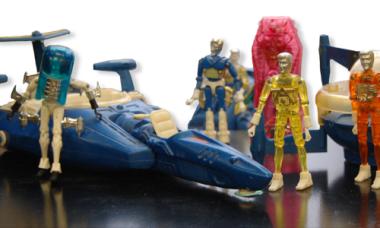We didn't care about melamine in 1978. Our plastic—and everything was plastic: cars, trees, children—leaked noxious fumes and yellowed in the sun instantly. And we were grateful. It was a heady time for young astronauts, and I was in training for the Mars mission that still has not materialized. (I've written NASA about this oversight, and they sent a form letter suggesting I buy space shuttle stamps.)
Star Wars had just sent my brain into orbit, and I was about space. Space in all its forms, from the Egyptian proto-mythology of Glen Larson's masterpiece of bad effects and worse actors, Battlestar Galactica, to the twin-engined star vessel on my Trapper Keeper.
Yet none of these, even Star Wars, provided the coolest of toys. That honor went, hands down, to Micronauts. There was no television show attached to this extensive line of questionable Asian plastic that, notably, preceded Star Wars. Whence they came, nobody knew. (Later a comic book series explored this notion, though many a kid no doubt came up with more interesting mythologies.)
Micronauts were pretty much the nerdiest of space toys in some respects. They were spawned by a very Japanese strain of weirdness, the same kind of sense-free plotting that brought us, for instance, a giant moth accompanied by twin pixies from a South Seas island (Mothra). Micronauts figures are well-coiffed androids who seem ready to anchor the news or play an invigorating round of tennis. They sport the delicate wrists and ankles of toy diplomats instead of rippling action-hero muscles. Their extensive motor pool of vehicles makes no sense, from the top-heavy rolling/flying tower-automobile to various water sleds and space bases.
But the genius of Micronauts was interchangeability—everything, from figures to space stations, came with uniformly sized sockets, and most required extensive assembly, offering endless combinations (the more you bought, that is). Want a centaur with a rocket engine? We can do that. Want to take the wing off your Battle Cruiser and shoot darts? No problem!
This, for the cosmic-minded '70s kid set, was bracing stuff. Dream it and you could build it. The house with chicken feet owned by Baba Yaga, the witch of Russian lore, was par for the course with these diminutive Japanese foreign service officers. A dragon with a beefy arm could be had in seconds for the enterprising youngster.
Nostalgia aside, Micronauts exemplify what makes toys fun and enduring. Their story was enigmatic, sketchy, so making it up as you went was necessary. Plot lines sprouted from unlikely, accidentally discovered contraptions. My box of Micronauts stayed under my bed, combining in my dreams into sprawling Neptunian architectures. (Though this also occasioned a major childhood tragedy: the discovery by my dachshund that Micronauts were eminently chewable.)
Such stuff can only be good for the gray matter. Toys weren't necessarily better then—an era that gave us mustard yellow cars and wide-collar polyester can't stand on its nobility for long—but the nutty Japanese toy designers who thought up such madness were onto something universal. Perhaps there are toys out there even now, combining into unlikely imaginings that my adult brain could scarcely comprehend. I only hope that Santa Claus has the presence of mind to bring them down the chimney instead of something with short-lived charms, multimedia extravagance and nothing to work for. In a time when finding one's way in a car doesn't require map-reading and software finishes our sentences, surely he owes kids that much.



